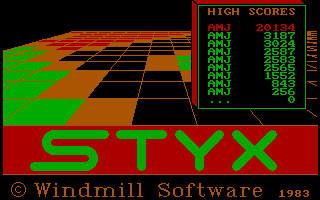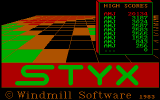 The Styx Story "Styx was the guardian of the sacred oaths that bound the gods." In 1983, it was trapped by a clever computer programmer but left to die in the graveyard of CGA games. Now it's back again... Styx in Mythology "In Greek mythology, Styx was the name of the river which was the entrance to the underworld. It was often described as the boundary river over which the aged ferryman Charon transported the shades of the dead. The river was personified as a daughter of the Titan Oceanus, and Styx was the guardian of the sacred oaths that bound the gods. The actual river, the modern name of which is the Mavroneri, is in northeastern Arcadia, Greece. It plunges over a 183m (600ft) cliff, then flows through a wild gorge. The ancient Greeks believed that its waters were poisonous, and the river was associated with the underworld from the time of Homer." (From "Styx", Microsoft (R) Encarta. Copyright
(c) 1993 The Styx Game The game "Styx" was originally created by Windmill software in 1983 and released as a copy-protected, bootable 5.25" floppy disk for the IBM PC/XT. As it requires a genuine CGA card, it didn't work on modern PCs. In 1998 a new version, "Styx Remastered", was created by Andrew Jenner which runs on all PCs with CGA or better, whilst retaining all the atmosphere and playability of the original. After completing the remastering of Digger, a very famous Windmill Software game, Andrew got many emails thanking him for restoring this great game. One of these Digger fans (Maarten Kramer from the Netherlands) came across Andrew's site whilst looking for another game, "Styx", also by Windmill software. At this stage Andrew didn't even know Windmill had created any other games, and when Andrew came across a copy of the original "Styx" (thanks to Daniel Backman), he quickly became addicted and decided that this would have to be the next remastering project. The game used a little known "tweaked" mode of the original CGA which allowed all 16 colours to be displayed on screen at the same time, although at a paltry resolution of 160x100. This sounds awful, but it was quite effective on CGA monitors (it was certainly a welcome change to be able to see all 16 colours at once) and was ideal for games of this sort (as you can see when you play it). Rather than redrawing all the graphics, as Andrew did with Digger, he just converted them directly, which made the operation a lot simpler. After a fun packed week of sifting through assembly code, Andrew finally got the thing to work on all graphics adapters better than or equal to CGA, and at more or less the correct speed. |
